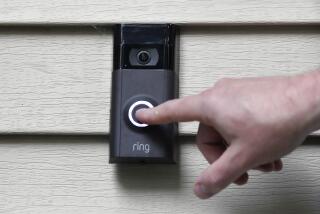Baby Bells Prepare for Big Changes in Industry : Communications: Regulations and increasing competition will force the structural transformation of the local monopolies.
- Share via
WASHINGTON — A recent appeals court ruling may have spared local telephone monopolies quick extinction, but the Baby Bells that enjoy these monopolies will soon face the most extensive structural challenges since the telephone was invented more than a century ago.
On the regulatory front, federal officials are finalizing rules that, beginning next year, will require carriers and business users to modify billions of dollars worth of phone equipment to handle new area codes, service codes such as 411, long-distance company access codes and other numbers.
Meanwhile, many local phone monopolies--such as Pacific Bell--are under siege by rivals trying to circumvent the lucrative local phone franchise by using cable TV networks to deliver phone calls.
“The telephone industry is facing more challenges now than it has in its entire history,” said James Bradford Ramsey, general counsel for the National Assn. of Utility Commissioners, which represents local regulators.
The Baby Bells will also have to deal with competition. Competition in local phone markets is being encouraged by a growing number of states that, in the absence of a clear federal policy, are adopting laws aimed at breaking up the local phone monopoly.
In response, the phone companies are hunkering down and tightening their belts. The seven regional Bell operating companies, which have laid off more than 100,000 workers in the last four years, have announced plans to let an additional 60,000 go by 1997. And they are fighting hard at the state and federal levels for permission to enter the lucrative long-distance market.
But holding on to profits may become more daunting at a time when the Federal Communications Commission is proposing far-reaching and costly technical modifications of the existing phone network--which is quickly running out of phone numbers and access codes.
To alleviate the demand being fueled by an explosion of fax machines, cellular phones and other high-tech communications devices, the FCC has proposed that more than 600 new interchangeable area codes--with middle digits other than “1” or “0”--be made available by early next year.
The proposal will require modification of or replacement of private branch exchanges, or PBXs, that cannot process the new codes, as well as changes in the software that routes calls through the phone network. (PBX equipment allows communications within a company and with the outside world.)
In addition, the access codes that some callers dial to select American Telephone & Telegraph, MCI or other long-distance carriers, will be converted from five digits to six starting next year. The change will mean pay phones, hotel switchboards and other devices will have to be modified to handle the new codes.
Finally, the FCC has proposed that the prefix “1” be used exclusively for calls with more than seven digits, ending its use in some states for local inter-exchange calls. The agency also plans to increase the maximum length of an international telephone number to 15 digits from 12 by 1997.
While the phone companies make those adjustments, a federal appeals court in Washington introduced another wrinkle recently when it ruled that the FCC cannot force local phone companies to give rivals space inside their own facilities to hook up independent telephone networks. The FCC is considering appealing amid predictions that the decision will raise competitors’ costs and slow efforts to open up the $100-billion local phone industry.
But although shares of some local phone company rivals took a beating on Wall Street after the court ruling, analysts and industry officials expect the momentum toward more competitive local phone markets to continue.
“There’s no question that when you move from a monopoly environment to a competitive one, there’s going to be some chaos and tumult,” said Terrence L. Barnich, former chairman of the Illinois Public Utility Commission, who heads his own Chicago consulting firm, Paradigm Resources Group.
The new era of local telephone competition began gathering steam last month when two telecommunications powerhouses announced plans to offer phone service via cable television.
Time Warner Inc., the nation’s second-largest cable TV operator, disclosed plans in early May to use its cable TV network to offer phone service in Rochester, N.Y.
Days after that announcement, Southwestern Bell Corp. said that next year it will provide local phone service in Montgomery County, Md., through the Hauser Communications Inc. cable unit the company acquired last year.
“We believe that the introduction of telephone service is the only revenue stream that can justify expansion of a cable (TV) system,” said Michael Gilliam, president of SBC Media Ventures Inc., the Southwestern Bell unit that is setting up the new venture. He added that some analysts may think the telephone service is a mature industry, but it still generates billions of dollars in profits a year.
Still, SBC and other entrants will have to surmount daunting technological and financial hurdles. Gilliam said his company will have to install scores of switches and replace about 40% of Hauser’s existing coaxial wire network with high-capacity fiber-optic cable in order to provide telephone service.
More to Read
Inside the business of entertainment
The Wide Shot brings you news, analysis and insights on everything from streaming wars to production — and what it all means for the future.
You may occasionally receive promotional content from the Los Angeles Times.










